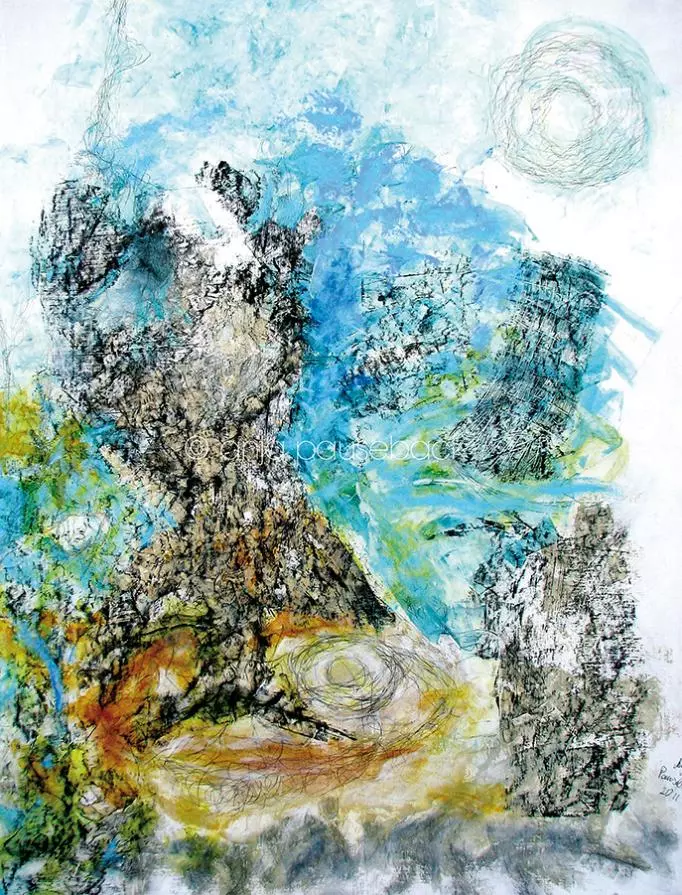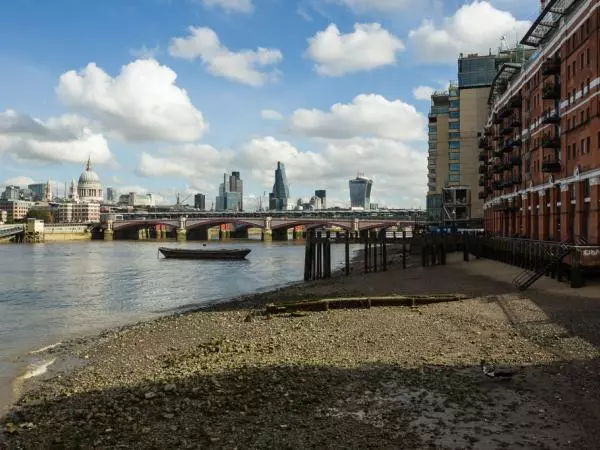Tanz der Vergänglichkeit - Danza della fugacità
L'asino (davanti a destra) con il suo cavaliere può essere visto come una metafora per la stupidità e l'uniformità, che ci trasmettono i mass media; la crescente disintelligenza, la mediocrità, cioè l'accontentarsi di risposte semplici. Una speranza sta ancora nella sua testardaggine. L'asino simboleggia, inoltre, la libido sessuale maschile, che può essere fertile ma anche distruttiva; simboleggia potenza, dissolutezza e libidine.
Una ballerina di flamenco (a sinistra) con le sue maniche a sbuffo e l'abito a balze gira al ritmo dei suoni che hanno accompagnato gli spagnoli nella loro lotta per l'indipendenza. Flamenco, la danza non convenzionale oppure anti-convenzionale come appello a sfidare la caducità. Non si può combattere la crisi con le stesse misure che ad essa ci hanno condotto.
Il sole (in alto a destra) splende e potrebbe illuminare una via (d'uscita). Le aree rimanenti in bianco rappresentano un piccolo ma ancora esistente spazio per cose nuove, la libertà. Prendiamocela per uscire da questa asineria.
Tra "I musicanti di Brema" è l'asino, che prende l'iniziativa e mostra agli altri animali una prospettiva per il futuro dicendo la frase famosa: "Qualcosa di meglio della morte lo trovi dappertutto". Forse un invito a fare qualcosa, invece di lasciar proseguire la sua opera alla fugacità senza opporle resistenza .
Ballate!
Tecnica: acrilico, matita, carboncino, olio, polvere di grafite su corpo di legno
Peso: 3,05 kg
----------------------------------------------------------------
Dance of impermanence
Pisa and its Leaning Tower are the symbol of the international programme for the assessment of pupils – and, not only as concerns results in Italy, of a cultural decline and loss of learning. Until the tower was reopened in 2001, its future was uncertain and there seemed to be no end to its plant-like fugacity.
The donkey (front right) with its rider can be seen as a metaphor for the stupidity and sameness relayed by the mass media. Its increasing lack of intelligence, its mediocrity, its contentedness with simple answers. There is still hope in the donkey's stubbornness. The donkey symbolizes, moreover, the male sexual libido, which can be fertile but also destructive; it symbolizes might, debauchery and lust.
A flamenco dancer (on the left) with her puffed sleeves and flounced dress turns with the rhythms that accompanied the Spanish in their struggles for independence. Flamenco, the unconventional or anti-conventional dance as a call to defy fugacity. A crisis cannot be fought with the same measures that have brought us to it.
The sun (upper right) is shining and could light a way (out). The other areas, in white, represent a small but still existing space for new things – freedom. Let's take hold of freedom to get away from this asininity.
In "The town musicians of Bremen" it is the donkey who takes the initiative and shows the other animals a prospect for the future with the famous line “We can find something better than death anywhere”. This may be an invitation to do something instead of letting impermanence do its work without meeting any resistance.
Dance!
(text: Katrin Walter simply.walter@yahoo.com; translation: Anna Ambrosini, Roma, immortalpalindrome@yahoo.it
 Share / Save
Share / Save









Commenti 0
Inserisci commento